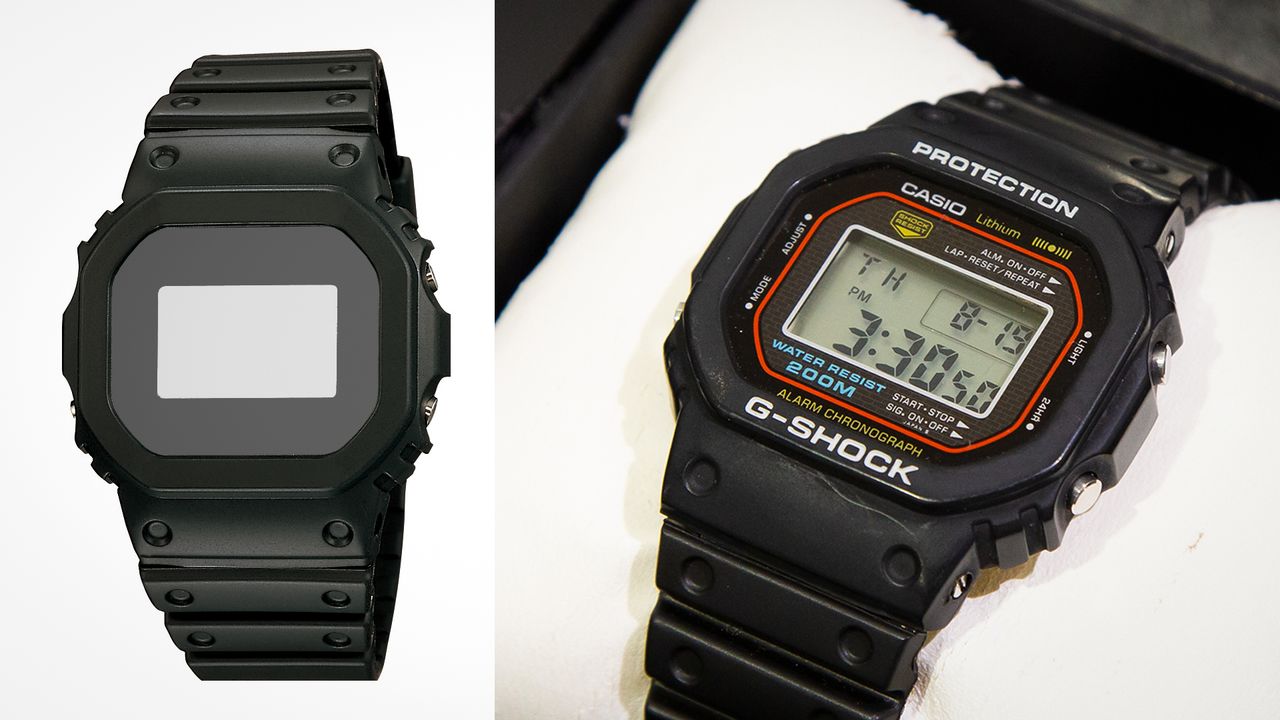
G-Shock Watch Granted 3-D Trademark for Iconic Shape
Design Fashion- English
- 日本語
- 简体字
- 繁體字
- Français
- Español
- العربية
- Русский
G-Shock Wins Rare Trademark
Casio’s digital G-Shock watch was created in 1983 based on the “triple 10” concept: 10-meter fall shock resistance, 10 bars of water resistance, and 10-year battery life. Its unique toughness has evolved over the 40 years since and has won it passionate fans worldwide.
On June 26, 2023, the G-Shock’s shape—without any logo, company names or other lettering at all—was granted a three-dimensional trademark by the Japan Patent Office. The authority based this on Article 3, Section 2 of the Trademark Act, saying that it qualifies because “consumers are able to recognize the goods or services as those pertaining to a business of a particular person”—in other words, because the shape has become truly distinctive for customers after its years of use. This is the first time in Japan that a watch has been so recognized. Now, these watches have been confirmed as not only uniquely durable, but uniquely shaped.
The trademark was granted for the shape initiated by the very first G-Shock, the DW-5000C model, with its distinctive square bezel. The current Origin series maintains this basic square design, which has contributed to its long popularity. Matsumura Satoko, head of Casio’s IP Legal and Licensing Department, says, “The first-generation model truly is a masterpiece for Casio. It has a polished design with no waste, and even today serves to help hone our technical capabilities, because whenever we incorporate new functions, we develop them to fit inside this case.” She goes on to explain that the company applied for a three-dimensional trademark in hopes that it would contribute to the company’s branding around the watch’s fortieth anniversary.

There is only one surviving first-generation G-Shock at Casio’s head office. (© Nippon.com)

Matsumura helped push the G-Shock’s three-dimensional trademark registration. (© Nippon.com)
Difficulties in Attaining Text-Free Trademarks
A three-dimensional trademark recognizes the right of protection for 3D shapes that distinguish a given good or service. The concept was introduced in Japan in 1996, and more and more companies apply every year. According to the Patent Office’s annual report, it received 311 applications in 2022, of which 202 were registered.
However, that 202 number includes applications including lettering. According to an investigation by Casio, of 50 registered trademarks without lettering, it seems only three have the same “distinctiveness through use” recognized for G-Shock.
Matsumura says that the company first sought to register the G-Shock for a three-dimensional trademark in 2005, but only succeeded with a mark including the logo and text. At the time, the watch had been on sale for over 20 years and had seen a major boom in the 1990s, but blank, text-free registration was simply too difficult.
The drive to reapply for text-free registration began in the fall of 2020. Yonekura Masako of the company’s Trademark and Design Section, who worked on the approach to registration, says, “The main requirement we had to clear was explaining the distinctiveness.” Essentially every watch consists of a case and strap, meaning they generally all look similar, so convincing the patent office would be a steep hill to climb.
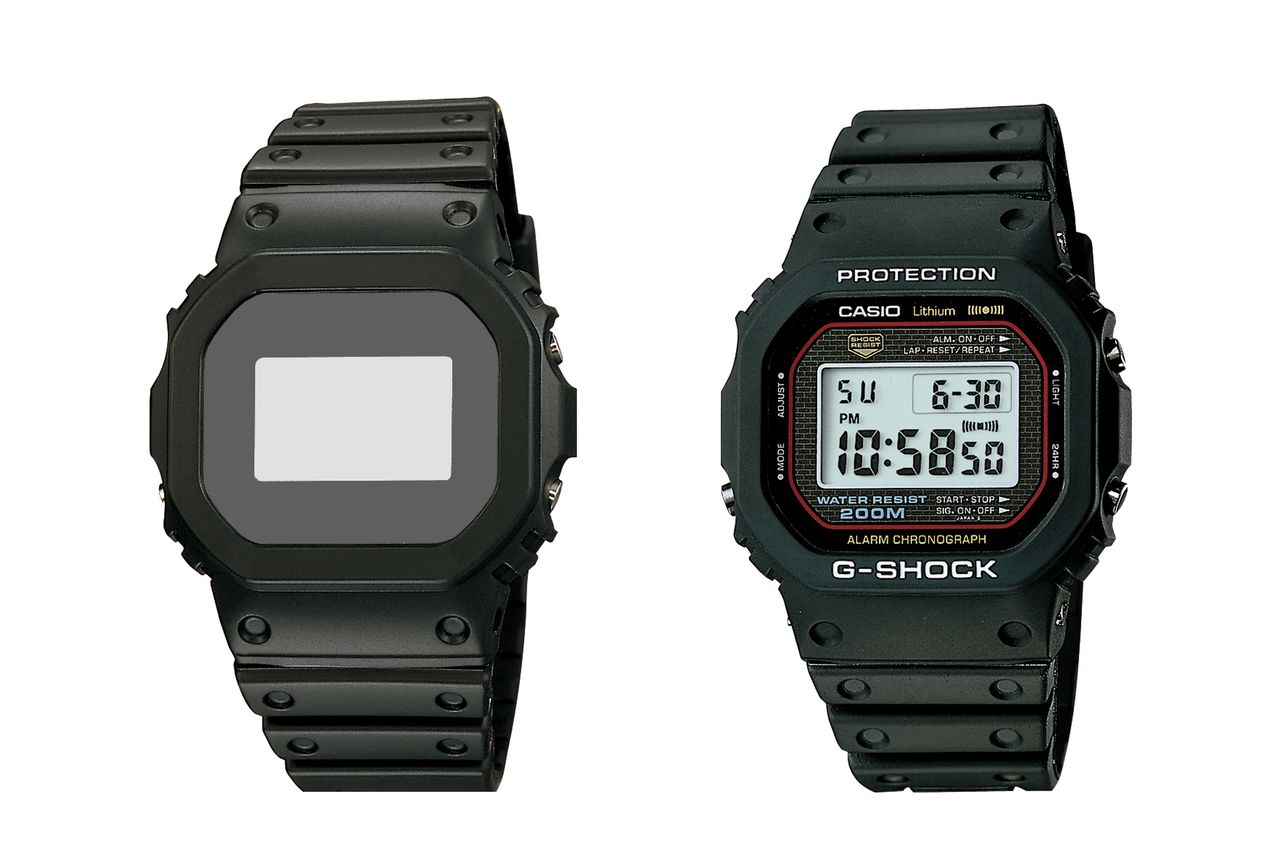
The image at left is the blank three-dimensional image that was successfully registered. Because Casio filed with a basic black and gray image, differences in color and material will also be covered. To the right is a first-generation DW-5000C model photographed from the same angle. (© Casio Computer)

The top-left watch is the first-generation model, while the rest are all subsequent variations on the design. (© Nippon.com)
The application was filed April 2021, and it took over two years for approval. Casio submitted massive amounts of supporting material, including the total number of G-Shock watches shipped—over 140 million—and sales numbers from over 140 countries, the number of products sharing the first model’s design, and copies of newspaper and magazine articles. One of the most persuasive arguments for distinctiveness, though, was a consumer survey.
A total of 1,100 people age 16 and up were presented with the logo- and text-free image like that used in the trademark application. The result was that in a free response question, 55% identified the shape as a G-Shock, while 66% did so in a multiple-choice question. Yonekura explains, “The fact that more than 60% of respondents in the multiple-choice question could distinguish it even without the logo was a better result than we’d expected. This survey and the overall three-dimensional trademark registration have helped display the G-Shock brand value.”
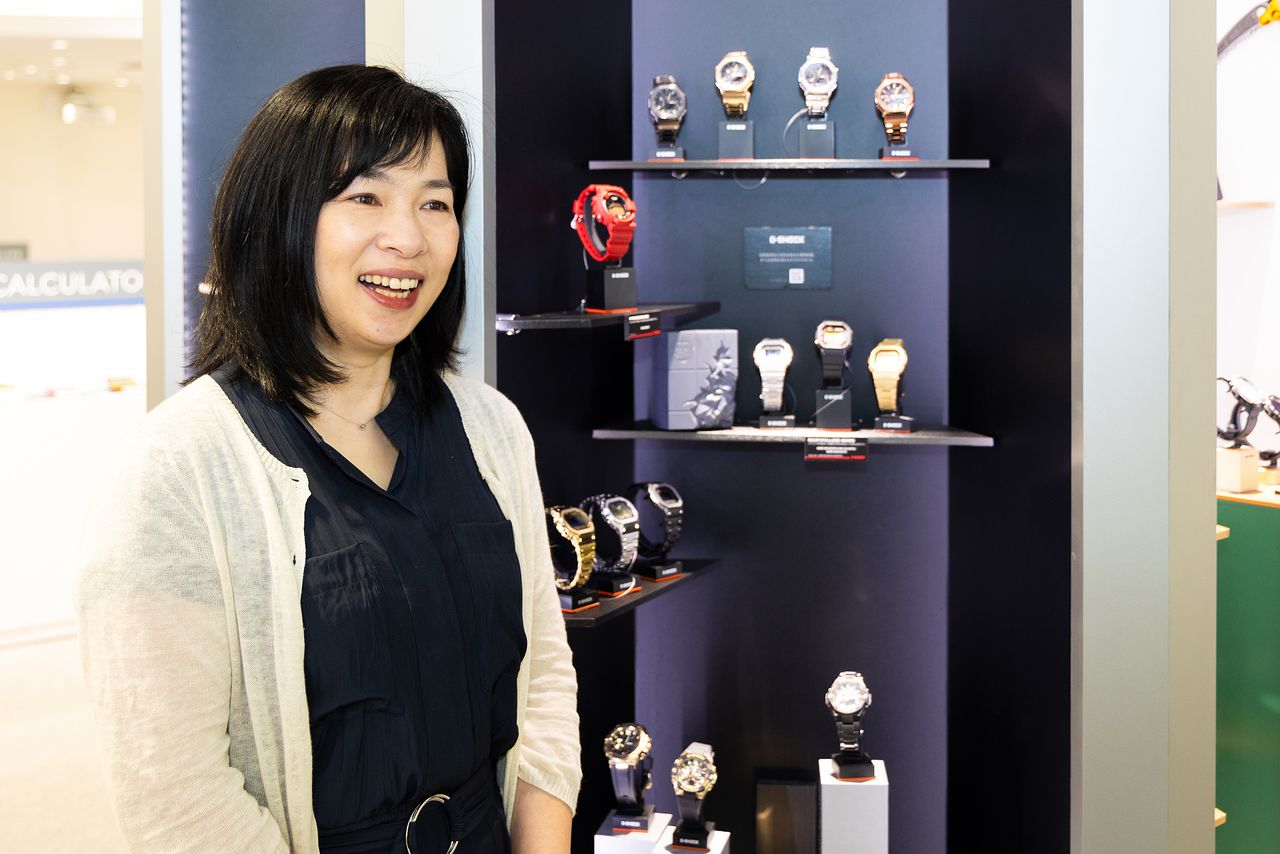
Yonekura was responsible for gathering the survey results and application materials. (© Nippon.com)
Popular Products with 3D Trademarks
In looking at past trademarks, we find that those without lettering read like a list of the most iconic “Made in Japan” products there are. Let’s take a look at a few.
The Kikkōman table-top soy sauce dispenser is registered both in Japan and in the United States. The bottle was the work of one of Japan’s great industrial designers, Ekuan Kenji, and since its release in 1961 has been sold in over 100 countries.
On top of its simply yet beautiful design, it is full of functionality, as well: the pourer has a downward sloping design that prevents dripping, the bottle’s neck narrows to make it easier to hold, and the bottom spreads out to prevent toppling. The bottle has become synonymous with soy sauce, such that even people who use other brands often refill them into this bottle. Another container, the Yakult plastic drink bottle, was registered in 2018, 50 years after it went on sale in 1968.
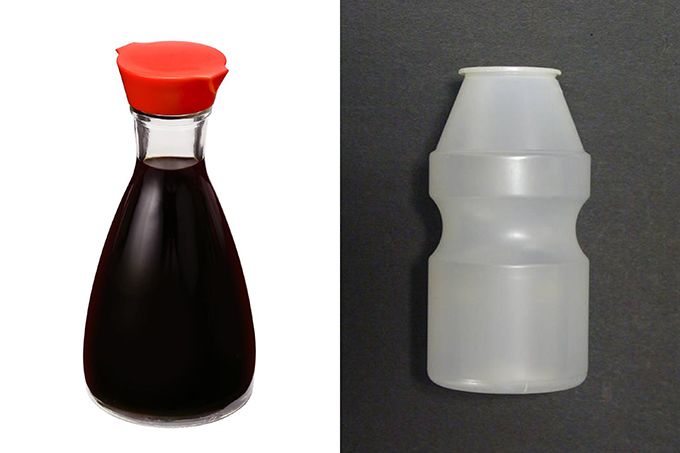
The Kikkōman tabletop bottle (Reg. 6031041) is to the left, and the Yakult plastic container (Reg. 5384525) on the right. (Courtesy J-PlatPat)
The Meiji chocolate treats Kinoko no Yama (on sale since 1975 and registered in 2018) and Takenoko no Sato (on sale since 1979 and registered in 2021) are also trademarked, but rather than the packaging, the shapes of the snacks, mushrooms and bamboo shoots, respectively, themselves made the grade. Surely their years of sales success and survey responses helped to show their distinctiveness.

Kinoko no Yama (Reg. 6031305) is to the left and Takenoko no Sato (reg. 6419263) is to the right. (Courtesy J-PlatPat)
It can be easy to show distinctiveness for products with lots of sales and reasonable prices, making them part of daily life, but a more unusual example is Honda’s scooter, the Super Cub.
Launched in 1958, the Super Cub is a super-long seller, but one with a persistent design concept. At the point that it achieved registration in 2014, it had sold of 87 million bikes in over 160 countries worldwide, making it the best-selling motorbike in the world. It was also the first vehicle to attain registration from shape alone, and one of the G-Shock’s few mechanical precedents.

The Super Cub (reg. 5674666) can be seen running worldwide. (Courtesy J-PlatPat)
A Home for Unfading Memories
All the hit products shown here ran into speedbumps on the way to registration, just like the G-Shock. But even when an application was initially denied, these companies went on to gather evidence that consumers see the distinctiveness, submitted surveys, and achieved their goal of trademark registration. Unlike patents, which have a limited duration, a trademark can be maintained forever if it is renewed every 10 years. It is a powerful right to hold, and that helps explain the difficulty of getting one for a text-free image.
When I asked Yonekura about how she felt after succeeding in such a difficult mission, she said, “I really understood the size of the G-Shock brand value,” as if she’d forgotten all about the hard work. She went on with a laugh: “I was happy to see all the comments on web articles and social media from G-Shock fans celebrating it.”
Matsumura also received an email from overseas which made her happy the company had tried again. It read, “My parents got me a G-Shock for my birthday when I was a child, and I am grateful to you for bringing those memories back.” She goes on to say, “I want to keep working hard on projects for intellectual property and branding. This was just the first step, and I think it was a good start.”
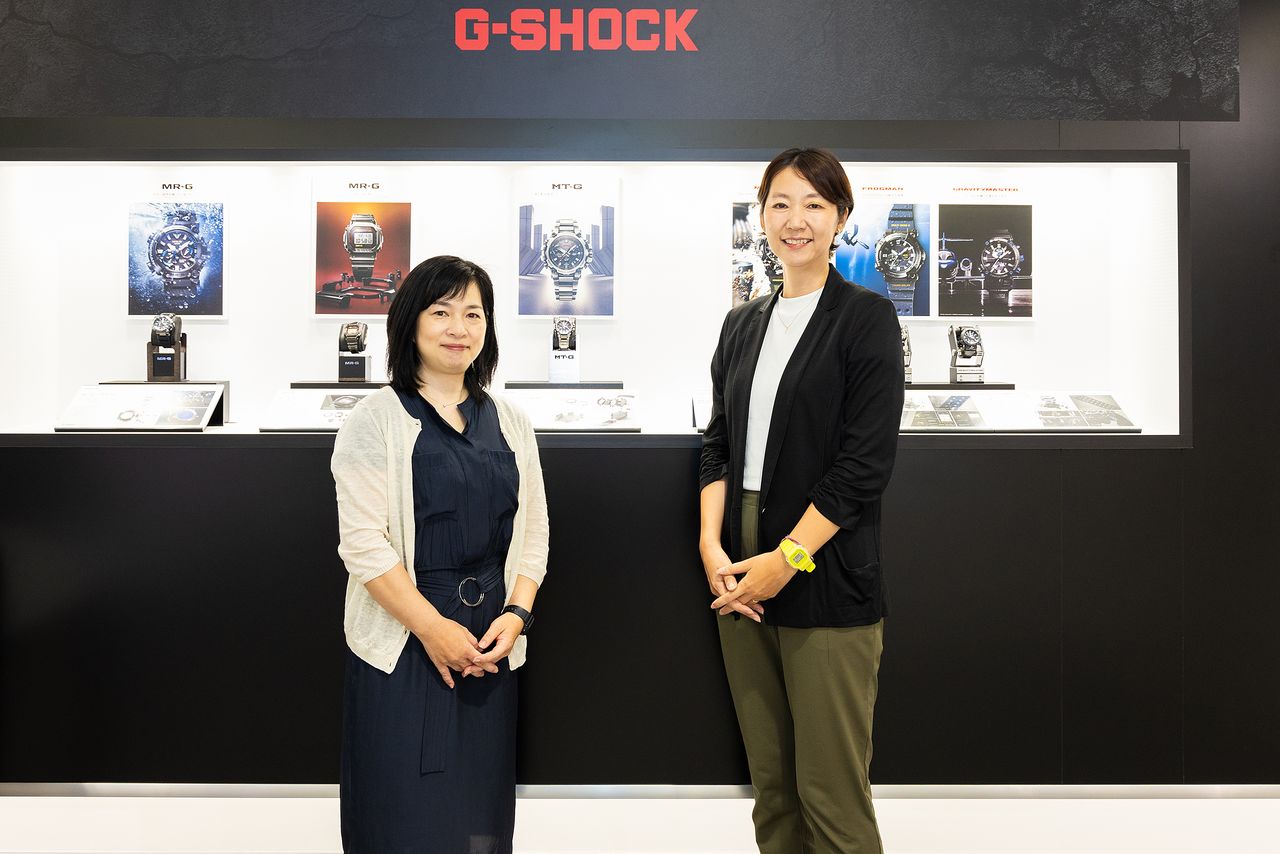
Yonekura and Matsumura at the Casio headquarters showroom. (© Nippon.com)
(Originally published in Japanese. Banner photo: The image that achieved three-dimensional trademark registration at left [courtesy Casio Computer] and the first-generation G-Shock model [© Nippon.com].)
Casio G-Shock intellectual property rights patent wristwatch trademark